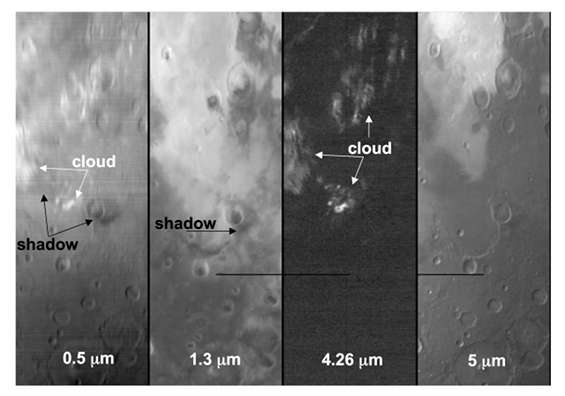Mars Express science highlights:
#9. Unambiguous detection of carbon dioxide clouds
The freezing and vaporisation of CO2 is one of the main climatic cycles of Mars, and it controls the seasonal variations in surface air pressure. The pressure rises as the CO2 ice vaporises at one pole during its spring, and then falls as CO2 ice forms at the other pole during its autumn.
Before the arrival of Mars Express, CO2 ice clouds were known to form in the very cold atmosphere above each winter pole, and they were also observed indirectly by NASA's Mars Global Surveyor. However, the observational record dramatically improved when direct observations of CO2 ice clouds became possible with ESA's orbiter.
Several Mars Express instruments (OMEGA, SPICAM, HRSC and PFS) made complementary observations of CO2 ice clouds at high altitudes in the martian atmosphere, particularly above the equator.
 |
|
Carbon dioxide ice clouds above Mars, viewed with OMEGA in late June 2004. Credit: ESA/OMEGA |
CO2 ice clouds were clearly detected by the OMEGA instrument, at wavelengths of 0.5 and 4.26 microns. The CO2 clouds were identified by a diagnostic spectral feature seen in the middle of a strong, saturated CO2 gas absorption band. The reflectance peak was produced by resonant scattering of photons by the high altitude CO2 ice crystals.
The clouds were found to vary from one martian year to another. (A year on Mars lasts 687 Earth days.) During the first year of observations, the clouds were mainly concentrated around the equator, particularly around the time of the northern summer solstice – midsummer in the northern hemisphere.
During the second year only three cloud features were detected, two before the summer solstice and one quite late in the year. The third year started with clouds frequently seen after the spring equinox, although the cloudy season ended earlier than during the first year.
Cloud shadows are also regularly observed. This is important, because it enables scientists to calculate their altitude – typically about 80 km. Analysis of these observations also revealed that the ice clouds are quite thick and dense, with a mean particle size of about one micron – much smaller than ice cloud crystals on Earth.
Even more remarkable was the SPICAM discovery of a fleeting layer of clouds at altitudes of up to 100 km - the highest clouds ever seen above any planetary surface. These carbon dioxide ice crystals form around a previously unknown population of minuscule dust grains, which measure only 100 nanometres across (a nanometre is one thousand-millionth of a metre).
